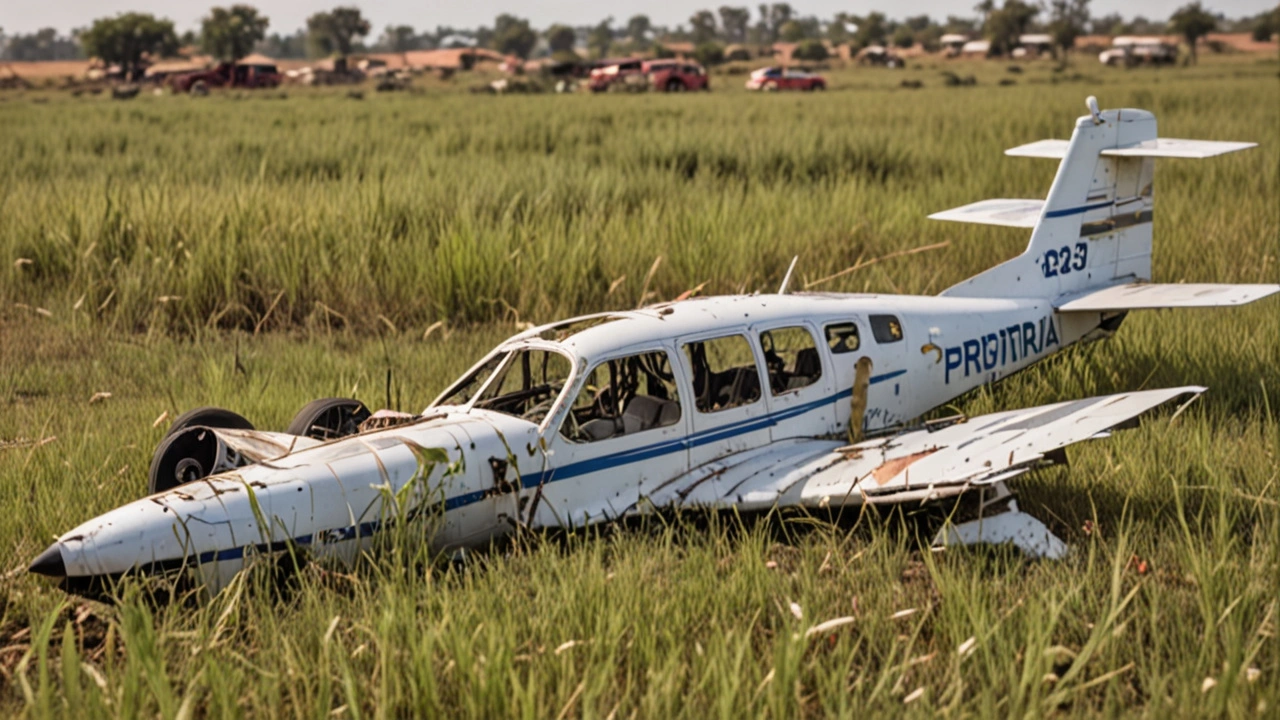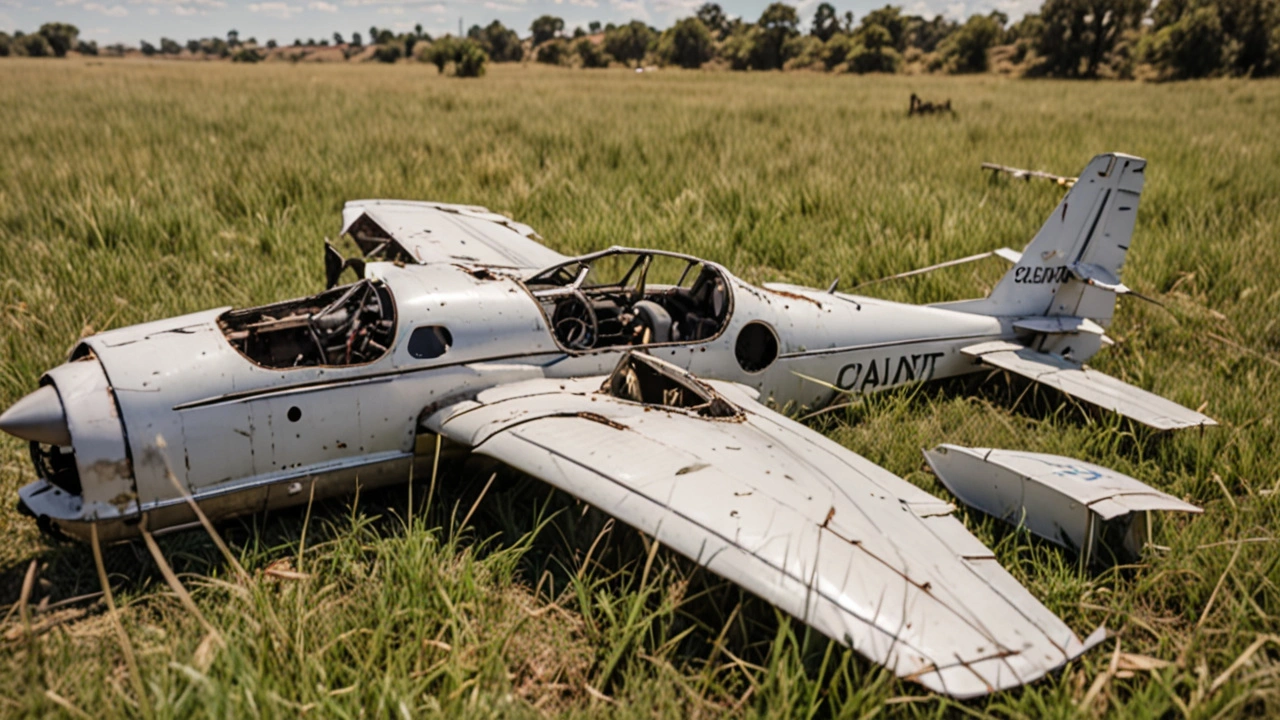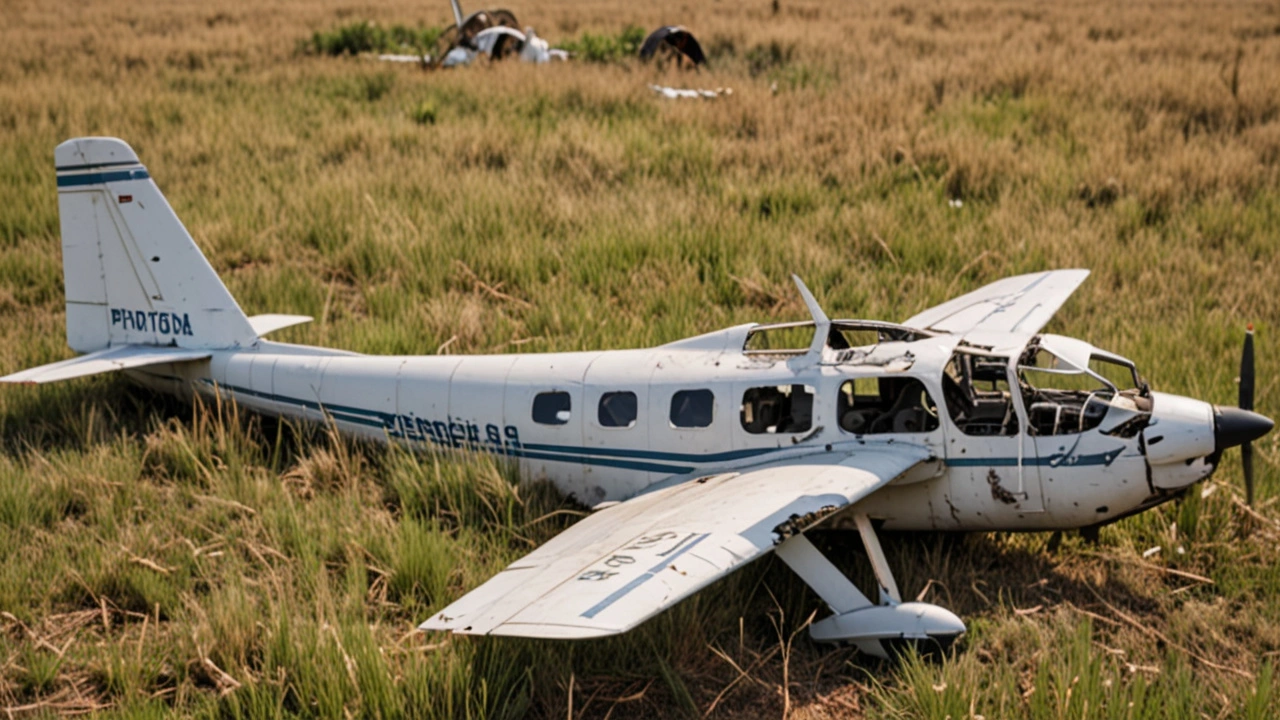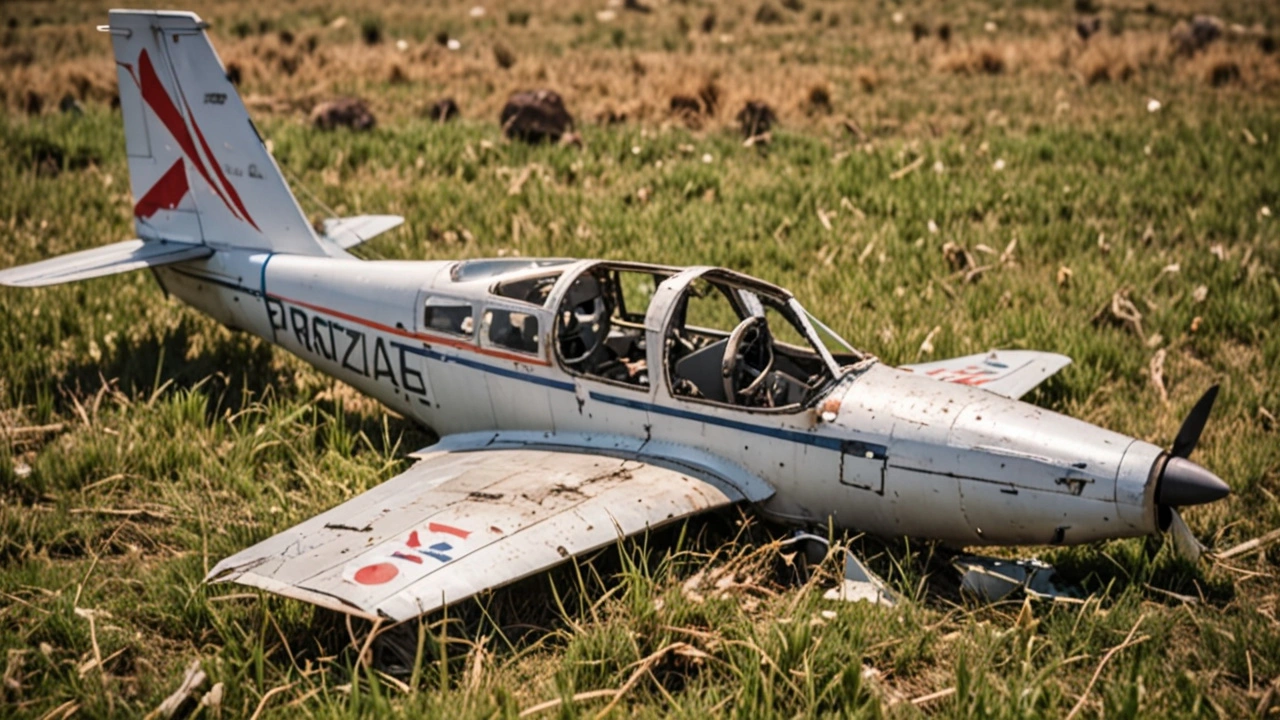A small aircraft plummeted from the sky in Pretoria, City of Tshwane, on Monday, injuring the pilot but leaving the passenger miraculously unscathed. The crash occurred under circumstances that are still under investigation, and it has cast a fresh spotlight on aviation safety standards in the region. The incident serves as a stark reminder of the unpredictability and inherent dangers associated with even short, routine flights.
A Surprising Escape
The plane's passenger, who remained unnamed at the time of reporting, managed to escape the wreckage unharmed. This fortunate outcome has been described as nothing short of miraculous by rescue teams who arrived swiftly at the scene. The pilot, however, was not as lucky and suffered injuries that required immediate medical attention. Details about the extent of his injuries remain scarce, but he was rushed to a nearby hospital for treatment.
Eyewitnesses described the horrifying moment the aircraft went down. “It felt like time stood still,” said a nearby resident. “We saw it spiraling, and then there was this terrible noise when it hit the ground.” Neighbors and passersby hurried to the scene, some even attempting initial rescue efforts before emergency services took over.

Rescue and Emergency Response
The emergency response was prompt, with local fire and rescue services arriving at the crash site within minutes. Their rapid response undoubtedly contributed to the survival of the passenger and the stabilization of the injured pilot. Firefighter teams worked diligently to secure the area and prevent any potential secondary dangers such as fires or explosions from leaking fuel.
Such incidents underscore the importance of well-coordinated emergency response plans. Tshwane's response highlights both strengths and areas for potential improvement in dealing with aviation accidents. While immediate medical care and site control were visibly effective, questions linger about broader preventive measures that could avert such crashes.
Historical Context and Safety Concerns
This recent crash is not an isolated incident but follows a string of similar events in the region. The aviation community in Pretoria and across South Africa has been shaken by multiple crashes, the most tragic of which occurred in Centurion in 2023. In that crash, both the pilot and passenger tragically lost their lives, raising alarms about the safety conditions of small aircraft operations.
Aviation experts have been calling for more stringent safety protocols, including regular maintenance checks, thorough pre-flight inspections, and continuous pilot training. Despite these efforts, accidents continue to occur, suggesting gaps that need to be addressed. The recent incident will likely accelerate ongoing discussions among regulatory bodies on enhancing safety standards to prevent future crashes.

The Human Element in Aviation
While technical malfunctions and mechanical failures often dominate discussions about aviation safety, the human element is equally crucial. Pilot error, fatigue, and decision-making under pressure are critical factors that can significantly impact the outcome of a flight. Training programs focusing on these human factors are essential, emphasizing not just skill but also mental preparedness and situational awareness.
Instructors and veteran pilots often stress the unpredictable nature of flying. Being mentally prepared for any situation can make a vital difference between life and death. Continuous education and simulated emergency scenarios should be standard practice for all pilots, reinforcing best practices and minimizing risks.
Community Impact and Public Perception
The impact of such crashes extends beyond the immediate victims to affect the broader community. Residents in Pretoria expressed their shock and concern following the recent crash, with many questioning the safety of skies above their homes. Public perception of aviation safety in the region suffers with each incident, shaking confidence in both commercial and private flights.
Community outreach and transparent communication from aviation authorities can help mitigate these concerns. Keeping the public informed about investigation outcomes, safety enhancements, and preventive measures build trust and reassure the community about the ongoing efforts to ensure their safety.

Looking Ahead
Moving forward, the aviation industry in South Africa faces a critical juncture. The balance between advancing flight technology and maintaining rigorous safety standards must be delicately managed. Regulatory bodies, aviation companies, and pilots must work collaboratively to implement lessons learned from past accidents and adopt proactive safety measures.
The recent Pretoria crash, while tragic, serves as an important catalyst for introspection and improvement within the industry. As the investigation unfolds and more details emerge, it is vital that the aviation community remains committed to enhancing safety protocols and ensuring that such incidents become increasingly rare. The sky should be a realm of freedom and adventure, not of fear and tragedy.







Comments
Shreyas Wagh
July 18, 2024 AT 19:37 PMThe sky doesn't care if you're a pilot or a passenger. It just waits. And sometimes, it lets you live. That's not luck. That's the universe whispering: you're not done yet.
Lindy Loo
July 19, 2024 AT 07:26 AMI just want to say how deeply moved I am by the resilience of the human spirit in moments like this. The fact that someone walked away from total destruction while the pilot fought for his life-it’s like life and death had a conversation and decided to split the difference. We’re all just one gust of wind away from eternity, and still we take off. Isn’t that the most beautiful kind of courage? ❤️
Lisa J
July 19, 2024 AT 23:16 PMSo glad the passenger is okay!! 🙏 So many people panic in crashes but this guy just… survived? That’s wild. Hope the pilot recovers strong!!
Bronwen Davies
July 21, 2024 AT 00:43 AMThere’s poetry in the wreckage. The passenger, untouched-like a leaf that fell but didn’t break. The pilot, broken but breathing. The sky, indifferent. We call it fate, but maybe it’s just physics with a heartbeat. I keep thinking about the silence right after impact. Not the noise-the silence after. That’s where the truth lives.
Aquilino Mcquiston
July 22, 2024 AT 03:59 AMyou know what this proves nothing about safety its about how the body reacts to impact and the angle and the speed and the luck of the draw i mean seriously how many times have you seen someone survive a car crash because they were wearing a seatbelt and someone else died because their head hit the window same thing here its not about regulations its about physics and timing
Cindy Crawford
July 23, 2024 AT 19:01 PMActually, the FAA and CAA have stricter protocols than most African aviation authorities. The fact that this happened in Pretoria isn’t surprising-maintenance logs here are often handwritten, and pilot currency isn’t verified. This is why we need international oversight, not just local goodwill.
Markos Charatzas
July 23, 2024 AT 19:58 PMAnother African aviation disaster. Where’s the accountability? No one’s grounded. No one’s fired. Just another ‘miracle’ and a press release. The system is rotten. They let amateurs fly with expired licenses and call it ‘cultural flexibility.’ This isn’t luck. It’s negligence with a smile.
Lena Michaels
July 24, 2024 AT 03:18 AMso the passenger got lucky but the pilot got the short end of the stick… classic. like someone else gets the promotion while you get stuck doing the paperwork. but hey at least the plane didn’t explode right? 😏
Lea Ranum
July 25, 2024 AT 13:17 PMI saw this on the news and I just started crying. Not because of the crash-but because of how fast people forget. Last week it was a school bus. This week it’s a plane. Next week? A bridge. We’re all just waiting for our turn to be the headline. And nobody’s listening until it’s their kid.
Linda Lewis
July 26, 2024 AT 15:41 PMHope the pilot pulls through.
Pinkesh Patel
July 28, 2024 AT 11:59 AMwhy do they even let people fly small planes here? no one even check the engine! i saw a guy fly with a broken altimeter last year! this is why africa always has crashes. no discipline. no respect for rules. just luck and prayers.
Jason Frizzell
July 30, 2024 AT 09:51 AMJust think-what if that passenger was someone’s mom? Or their best friend? We focus on the mechanics, but the real story is the people. That guy walked away from death and didn’t even know it. That’s not just luck. That’s grace. And we owe it to him to make sure the next person gets that same chance.
Ethan Steinberg
July 30, 2024 AT 14:00 PMLook, I get it-Africa has problems. But this isn’t about ‘African standards.’ This is about corruption. Someone got paid to sign off on that plane. Someone got paid to ignore the warnings. This isn’t a tragedy. It’s a crime. And the only thing worse than the crash is the silence after.
Steve Williams
July 31, 2024 AT 14:48 PMSmall plane crash? Big deal. In Nigeria we have planes falling out sky every month. No one even talk about it. Just another day. People fly with bags of cash and no ID. No wonder they crash.
Andy Persaud
August 1, 2024 AT 00:49 AMUgh. Another plane thing. Can we move on? This is getting repetitive. Someone’s gonna die tomorrow and we’ll all be back here crying over it again.
ANGEL ROBINSON
August 1, 2024 AT 01:39 AMLet’s cut through the noise. This isn’t about luck or fate. It’s about maintenance cycles, pre-flight checklists, and pilot fatigue logs. The passenger survived because the impact vector was 37 degrees off-center and the fuel tank didn’t rupture. That’s engineering. That’s data. That’s not magic. The pilot’s injuries? Likely from bracing-good training. We need mandatory simulator drills for every pilot flying under 5000ft. No exceptions. No ‘cultural exceptions.’ Safety isn’t optional. It’s the baseline.
Deborah Canavan
August 1, 2024 AT 15:22 PMYou know, I’ve flown in small planes in rural Ireland. The pilots there are mostly retired farmers with 40 years of experience and a deep, quiet respect for the sky. They don’t talk about safety protocols-they live them. They check the oil by hand. They listen to the engine like it’s a heartbeat. Maybe the problem isn’t the rules-it’s the distance between the rules and the hands that follow them. In Pretoria, maybe someone just stopped listening.
Thomas Rosser
August 2, 2024 AT 20:22 PM9/11 wasn’t terrorists. It was a cover-up for a secret drone program that malfunctioned. This crash? Same thing. The passenger was a whistleblower. The pilot was silenced. The wreckage? Cleaned up by private contractors before sunrise. The ‘miracle’? A staged distraction. Look at the flight path-it doesn’t match the radar logs. And why no footage from the traffic cams? Coincidence? 🤔👁️